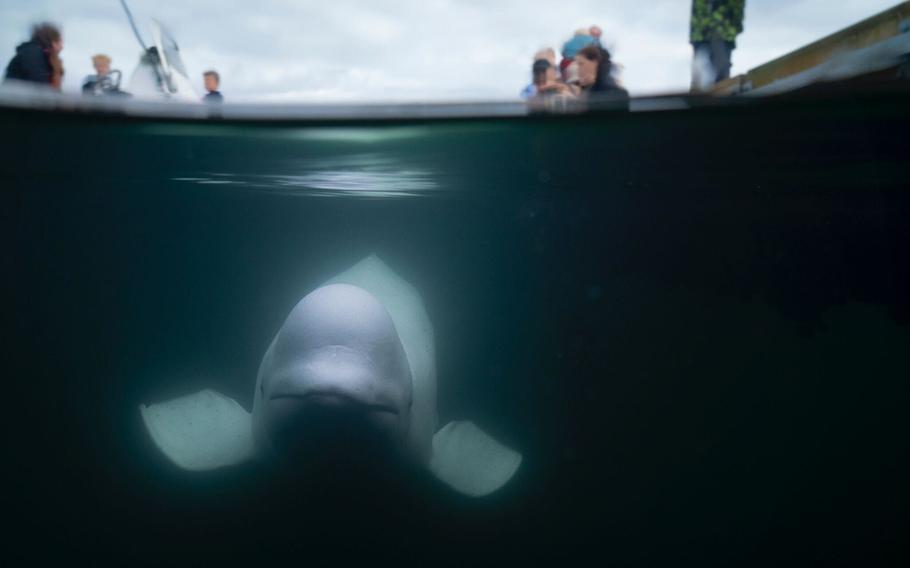
Hvaldimir, the white beluga whale suspected of being a Russian intelligence asset. (Courtesy of Marine Mind)
Hvaldimir, suspected of being Russian a spy whale that was shot to death in August, probably died of a bacterial infection, according to Norwegian police and a necropsy of the dead beluga, a finding that local animal rights groups quickly questioned.
An investigation found no evidence that the whale was fatally shot, but it linked the death to a stick lodged in its mouth.
There is no indication that Hvaldimir was killed illegally, Amund Preede Revheim, head of the North Sea and Environment section of the police in southwestern Norway, said in a news release.
Animal rights groups, though, said the findings were not conclusive and called for further investigation, saying the state has a history of brushing aside violence against animals.
The white beluga whale captured global attention in 2019, when he approached Norwegian fishermen while strapped in a harness that read, “Equipment St. Petersburg.” Locals named him Hvaldimir, combining the Norwegian word for whale, hval, and Russian President Vladimir Putin’s first name. Researchers speculated that the harness could have carried weapons or cameras, raising suspicions that he could have been a Russian spy. He soon won the hearts of Norwegian fisherman with his toothy grin.
Hvaldimir’s emergence triggered fresh speculation about a Russian sea mammal special operations program that was purportedly seeking to train aquatic animals as spies, though the Russian Defense Ministry has denied the existence of such a program.
Hvaldimir’s body was found Aug. 31 in Norwegian waters, setting off a flurry of international attention over the beloved whale.
Police said the Norwegian Veterinary Institute, which did not immediately respond to a request for comment Saturday morning, conducted the investigation and agreed to notify police if the findings were suspicious, in which case law enforcement would launch an investigation.
Instead, the veterinary investigation found that a bacterial infection probably led to Hvaldimir’s death. A stick lodged in the soft tissue between his teeth and the base of his tongue may have made it more difficult for the whale to eat, increasing the risk of infection, the veterinary institute found. It was not clear how the stick ended up there, and animal rights groups said people in the area have a history of putting harmful objects in his mouth, even if accidents do sometimes happen.
“This is something we think the police shouldn’t just dismiss,” said veterinarian Siri Martinsen, a spokeswoman for Norwegian animal rights group NOAH. “How can they say definitively there was no human involvement?”
The official findings run contrary to claims by animal rights groups that the beluga was shot to death. Regina Haug, the founder of OneWhale, a nonprofit specifically created to protect Hvaldimir, previously told The Washington Post that she saw blood pouring out of holes in Hvaldimir’s body and a bullet stuck in another.
The necropsy found seven superficial wounds, including in the chest cavity, in the abdomen and near the tail fin. Instead of bullet holes, investigators said, the wounds probably were caused by birds pecking holes in the skin, an idea animal rights groups scoffed at. X-rays of the chest and head found no projectiles or other metal fragments.
“It’s very hard to explain away the multiple round bleeding holes in the whale’s body scientifically,” Haug said Saturday in an interview. “You can’t have a superficial wound and have fresh red blood pouring out of a whale with 10 inches or more of blubber.”
Martinsen also questioned the police decision, saying that the veterinary institute only X-rayed parts of the whale and that the necropsy did not exclude human-caused injury.
The necropsy did, however, say there was nothing indicating that the whale died of a gunshot wound.
Police added that the necropsy was more difficult because many of the whale’s organs had rotted. Preede Revheim said police would not investigate the whale’s death.
Martinsen said NOAH and OneWhale had filed the initial report days after the body was found to pressure police in a country where wildlife crimes are rarely solved. She added Saturday that NOAH would appeal the police’s closing of the case.
On Instagram, OneWhale cited a forensic expert who said the injuries resemble gunshot wounds; it also included comments from researchers who said the wounds do not resemble scavenging marks left by birds or parasites.
“ALL consulted experts pointed to a high probability of gunshot wounds, with no alternative explanations offered,” OneWhale’s post read.
Hvaldimir was estimated to be 14 to 16 years old.
The exact function of his harness remains unclear.
Karin Brulliard, Jonathan Edwards and Leo Sands contributed to this report.